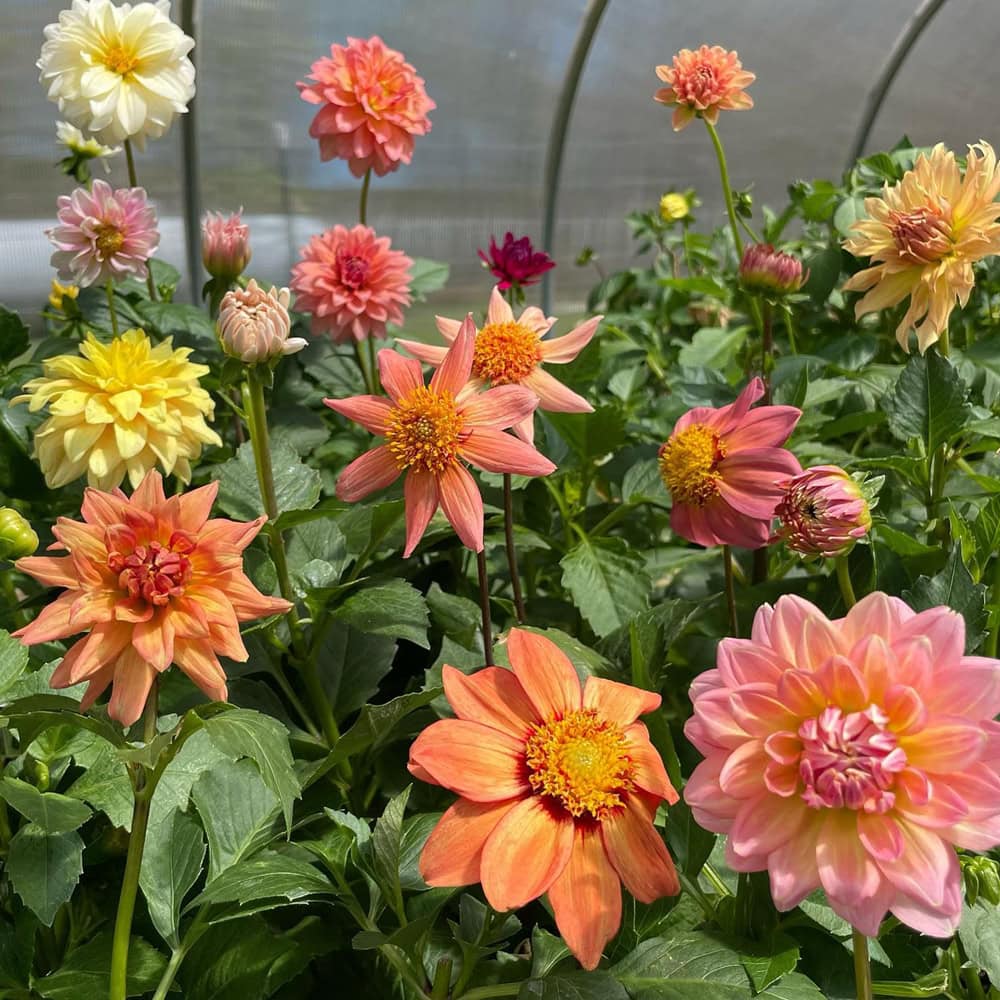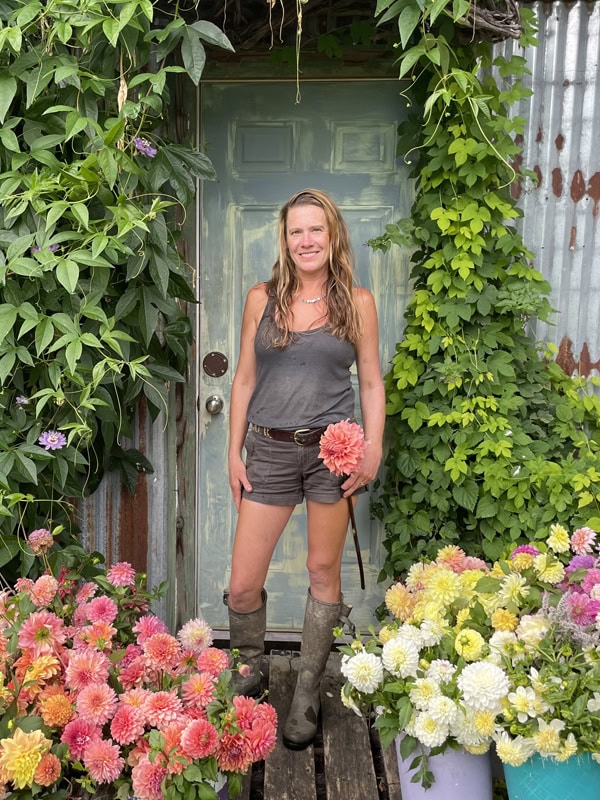After years of designing and installing large-scale landscape gardens in Georgia, Lee Hemmings Carlton relocated to North Carolina, near Boone, and named her new adventure Goldenrod Gardens.
Lee started with planting gardens of chef-loved specialty vegetables and florist-sought-after flowers. She also made highly coveted wreaths and bouquets for local farmer’s markets.
“Chefs gobbled up my specialty vegetables and florists came early to the market to snag my most coveted flowers, and I spent hours making bouquets on-demand to fit any budget every Saturday for years. I never showed up without plenty of foraged cut flowers, foliage and berries because they made those bouquets unique,” says Lee.
WRITTEN BY Bek Mitchell-Kidd
PHOTOGRAPHY BY Goldenrod Gardens

During this time, Lee realized just how many dahlia tubers she was producing and that other growers really wanted the varieties. Lee says, “I’ve been sourcing all kinds of plants for 25 years. I’m good at it because I manage to stay ahead of trends and forge my own path. It’s been the same with dahlias, and I have obtained my stock from as many as 14 different growers across the country in any given season.”

A 35-acre farm pasture, which encompasses a forest and terraced growing beds, is home to Lee and her husband David Wimmer. The Goldenrod Gardens farm is not open to the public.

“We erected a 72-foot greenhouse on the farm to accommodate the plants I needed to grow for several large second-home garden clients. Every late October, we turn the heat in there down to the lowest setting and use the space to process, store and pack orders of dahlia tubers gleaned from the 8,000-plus plants we grow,” says Lee.

Lee divides her time between breeding dahlias and select plants for floral design, managing residential clients’ gardens, and even taking on a few commercial projects, including the Wilson Center for Nature Discovery in Linville, N.C. The Center’s gardens intend not only to educate visitors about the local flora, but also to provide inspiration they can take home. Lee says, “I have an interesting set of skills that make me a great fit as the horticulturist for this endeavor. Working in collaboration with landscape architect Ron Cutlip, we are creating outdoor spaces that immerse visitors in the beautiful plant diversity the native ecosystem provides.”

Lee’s love of dahlias—from tubers to flowers—is a color love affair. “I’m most drawn to the flowers that either emit a natural glow or have an unusual matte appearance (I coined the term ‘chalky’ for those). I’m obsessed with color in general and love the entire spectrum, but I am drawn to warm oranges in any intensity—from the palest apricot to the richest bronze and the range into peach and peachy,” says Lee.

Lee taught herself how to divide dahlia tubers with patience, practice and the right tools to make the most of the clumps Goldenrod Gardens divides. She is also renowned for her knowledge of many individual varieties, including tuber shape, size and early presentation of the “eyes” (points where vegetative growth emerges in the spring) which can differ as much as the flowers themselves.

“With careful selection, a breeder can hone their strains down to the point of being able to consistently produce stellar offspring of a particular form. At the same time, if it is left up to the bees to do the pollinating, you never know what will bloom from those saved seeds, although many of the traits the parents carry will express themselves in one way or another,” explains Lee.
Even with several experienced helpers including Lee’s husband and son Morrison, every season it takes more than a month to dig, wash, divide, count and pack all of the tubers for winter storage. Lee sells out 80% of her stock within hours of listing them on the website, and they ship all over the country.

Lee cautions that a common mistake growers make with dahlias is related to cold wet soil, warning, “Don’t pot up dahlia tubers and water them—they are not growing yet, don’t have roots and don’t need water. I realize that watering new plant babies is a hard thing to resist, but go against the urge to water until there is vegetative growth. Once they are actively growing, they will tell you when they are thirsty.”

Lucky for us, Lee has compiled all her know-how into a book, Cut Flowers, Foliage & Fruits of the Southeast, which is available through the Goldenrod Gardens website and most online bookstores. The book has three main sections, covering sustainable, safe foraging and basic harvest and post-harvest tips. It also includes a photographic and colorfully descriptive field guide for 120 species with helpful keys for each denoting where they can be found, seasons they are the most ornamental and parts most useful in floral design. A series of floral design tutorials—organized from spring through winter—is also provided, utilizing native plants and commonly grown garden flowers and foliage with step-by-step photos and instructions.


“Plants have always been my chosen medium but creating a palette specifically for a vertically grown mass and not only being able to ‘paint’ with the plants as I install them, but also seeing them grow and fill out that space, is absolutely thrilling to me.”
Early fall, Lee’s favorite time of year, led to her choosing the name of her business. In mid-September, mountain pastures, woodlands and roadsides start to glow. Royal purple ironweed, fuchsia pokeweed stalks, sky blue and cloud white asters are all begging for attention as the light shifts, but the rich yellow goldenrods set the stage. “I love the beauty and diversity of goldenrod and I think there is a place for many of the species in both public and home gardens.”
Lee explains that goldenrods are keystone species in many native plant communities—their nectar fuels the monarch butterfly’s migration to Mexico, many bee species rely on the pollen to feed their larvae and the seeds provide protein to songbirds in the winter. As land is cleared and developed, we begin to lose our native plants. If we fail to find a place for them in this post-wild world, they will be lost. “When they go, so will the creatures that rely on them— everything is connected—and to me, it would be a very bland world without that diversity.”
WHERE TO FIND GOLDENROD GARDENS FLOWERS AND TUBERS
• When in bloom, freshly cut dahlias are available through Callista Flower Co.
• Wholesale florists can contact Goldenrod Gardens directly for bunches of dahlias with the perfect colors for designs as well as foliage, peonies, baptisia and various fillers, depending on the season.
• Online dahlia tuber presale opens mid-November on a Friday at noon EST on the Goldenrod Gardens website. Many varieties sell out very quickly.
• For information on special projects, including installing a vertical garden or naturalistic landscape, contact Goldenrod Gardens directly.
• Signed copies of Lee’s book are available on the website.
• David Wimmer pottery vessels will also be available for purchase soon.


Leave a Reply